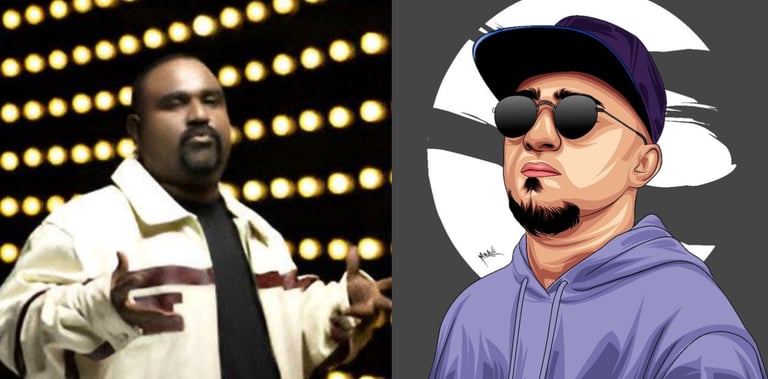The Rise of the South Side: A Deep Dive into South Indian Rappers and Their Impact
4/29/20253 min read


While the booming Desi Hip Hop scene often brings to mind the gritty streets of Mumbai or the swagger of Delhi and Punjab, a vibrant and increasingly influential wave of artists is emerging from the southern states of India. Rappers from Tamil Nadu, Kerala, Karnataka, and Telangana, among others, are carving out a unique identity, blending their rich cultural heritage, linguistic nuances, and distinct perspectives into the global hip-hop landscape.
Breaking Linguistic Barriers and Stereotypes:
One of the most compelling aspects of South Indian hip-hop is its embrace of regional languages. While some artists do incorporate English and Hindi, many are fiercely proud of rapping in Tamil, Malayalam, Kannada, and Telugu. This linguistic diversity adds a rich tapestry to the genre, offering unique sounds, cadences, and lyrical themes that resonate deeply with local audiences while simultaneously piquing the interest of global listeners seeking something beyond the familiar.
Pioneers and Influencers:
The seeds of hip-hop in South India were sown by artists who dared to experiment and fuse Western sounds with their cultural roots. While the mainstream explosion might be more recent, several key figures laid the groundwork:
Yogi B (Tamil Nadu): Often hailed as the "Godfather of Tamil Rap," Yogi B emerged in the early 2000s, blending raw and aggressive Tamil lyrics with hip-hop beats. Tracks like "Madai Thiranthu" were foundational in establishing a distinct Tamil rap sound.
Brodha V (Karnataka): Based in Bangalore, Brodha V (Vighnesh Shivanand) gained recognition for his intricate flows, witty lyricism, and his ability to blend hip-hop with elements of Hindustani and Carnatic classical music. Tracks like "Aathma Raama" and "Aigiri Nandini" showcase his unique fusion.
The New Wave and Gen Z Revolution:
The South Indian rap scene is currently experiencing a dynamic surge, fueled by a new generation of artists who are leveraging online platforms to reach wider audiences. This "Gen Z Flow," as some describe it, is characterized by experimentation, bold social commentary, and a strong sense of regional identity:
Hanumankind (Karnataka/Kerala): Sooraj Cherukat, known as Hanumankind, has rapidly gained fame for his sharp lyricism, innovative sound, and energetic performances. His viral track "Big Dawgs," shot in Kerala and featuring intense visuals, has garnered millions of views and put South Indian rap on the global map. His ability to blend global hip-hop influences with his South Indian roots is captivating.
Arivu (Tamil Nadu): A powerful voice in Tamil rap, Arivu is known for his socially conscious lyrics that address issues of caste, class, and inequality. His work often incorporates elements of Tamil folk music, creating a compelling and authentic sound.
Dabzee (Kerala): A prominent figure in Malayalam hip-hop, Dabzee gained significant recognition for his unique flow and production style. He has also made inroads into the Malayalam film industry, showcasing the growing integration of rap into mainstream South Indian culture.
ThirumaLi (Kerala): Another influential Malayalam rapper, ThirumaLi is known for his impactful lyrics and his role in popularizing the genre within the Malayali community.
MC Couper (Kerala): A versatile artist in the Malayalam hip-hop scene, MC Couper is known for his dynamic delivery and diverse thematic content.
SIRI (Karnataka): A prominent female voice in the Bangalore rap scene, SIRI delivers hard-hitting bars in English, often addressing themes of identity and female empowerment.
Regional Hubs and Emerging Sounds:
While Bangalore and Chennai are often cited as key hubs, vibrant rap scenes are also developing in other South Indian cities, each with its own distinct flavor:
Kerala: The Malayalam hip-hop scene is particularly strong, with a dedicated fanbase and a growing number of talented artists pushing the boundaries of the genre. Events like the "Ocha Music Festival" highlight the burgeoning talent in the state.
Hyderabad: The Dakhani rap scene, blending Urdu and local dialects, is gaining traction with artists like Thugs Unit and Pasha Bhai.
Themes and Lyrical Content:
South Indian rappers are tackling a wide range of themes in their music:
Social Commentary: Many artists use their platform to address pressing social and political issues, giving voice to marginalized communities.
Cultural Identity: Celebrating regional languages, traditions, and histories is a central theme for many South Indian rappers.
Personal Narratives: Artists also delve into their personal experiences, struggles, and triumphs, creating relatable and authentic music.
Fusion of Sounds: The blending of traditional South Indian musical elements with contemporary hip-hop beats is a defining characteristic of the scene.
The Future is Bass Heavy:
The South Indian rap scene is no longer an underground subculture; it's a dynamic and rapidly expanding movement. With more artists gaining mainstream recognition, collaborations with established musicians, and the power of online platforms amplifying their voices, the future of South Indian hip-hop looks incredibly bright. These artists are not just adding to the Desi Hip Hop narrative; they are enriching it with their unique stories, languages, and sounds, proving that the "South Side" has a powerful and distinct voice to be heard on the global stage. Keep your ears to the ground, because the beats coming out of South India are only getting louder and more compelling.

Comment Down
Send your Articles
Stay updated with the latest hip hop trends.
Stay Connected
rap@grillg.com
+91-9911428513
© 2024. All rights reserved.
